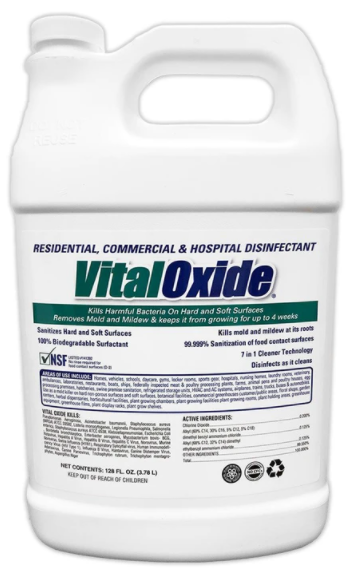
VITAL OXIDE is an EPA-registered hospital disinfectant cleaner, mold and mildew killer, and odor eliminator. With its ready-to-use formula designed to be gentle to users but tough on germs, Vital Oxide disinfectant is non-irritating to skin, non-corrosive to most treated articles, NSF-certified (no rinse required) for food-contact surfaces, and listed as a category IV (lowest toxicity category) pesticide with the EPA. With every bottle of Vital Oxide comes the promise that we are actively working toward environmentally sound cleaning and disinfecting solutions.
100% BIODEGRADABLE SURFACTANT
COVID – 19
Vital Oxide disinfectant has been approved by the EPA for use against SARS-CoV-2, the coronavirus that causes the Coronavirus Disease 2019 (COVID-19). It meets the EPA’s emerging pathogen requirements for viruses showing efficacy against envelope and non-envelope virus, both large and small.
To use Vital Oxide against SARS-CoV-2, follow the directions on the label for use against Canine Parvovirus (Strain Cornell-78916, ATCC VR-2016) on hard, non-porous surfaces.

7 SOLUTIONS IN ONE

EPA REGISTERED HOSPITAL DISINFECTANT CLEANER
Proven to kill a wide range of viruses and bacteria, won’t contribute to the formation of nutating “super bugs”, and does not contain volatile organic compounds (VOCs).

NSF REGISTERED (D-2) NO RINSE REQUIRED FOOD CONTACT SURFACE SANITIZER
Kills 99.999% of food borne bacteria including E.coli, Salmonella, and Listeria in less than 60 seconds.

MOLD & MILDEW KILLER
Kills and prevents spores with up to 7 months residual effects. Safe on a wide range of surfaces from marble to carpeting and beyond.

ODOR ELIMINATOR
Ends malodors caused by smoke, trash, septic systems, stale cooking, and more. Contains no masking agents or fragrances and is highly effective at neutralizing urine and fecal odors.

ALLERGEN ELIMINATOR
Proven effective on pet dander as well as dust mite and cockroach allergens. Can be used directly on pet bedding and sleeping areas.

HVAC & AIR DUCTS
Used in HVAC systems and air ducts for antimicrobial control, including eliminating bacteria, mold, mildew, and other fungi. Leaves HVAC systems and air ducts free of microbial contamination and ensures air quality.

SOFT SURFACE SANITIZER
Used on a wide range of soft surfaces. Kills odors and odor-causing bacteria on soft surfaces by eliminating the source. Great for upholstery, curtains, and auto interiors.
AREAS OF USE – Homes, vehicles, schools, daycare, gyms, locker rooms, sports gear, hospitals, nursing homes, laundry rooms, veterinary, ambulances, laboratories, restaurants, boats, ships, federally inspected meat & poultry processing plants, farms, animal pens and poultry houses, egg processing premises, hatcheries, swine premise sanitation, refrigerated storage units, HVAC and AC systems, airplanes, trains, trucks, buses & automobiles. Use as a mold controller & mildewstat on hard non-porous surfaces and soft surfaces, botanical facilities, commercial greenhouses, customer/public areas, floral shops, garden centers, horticultural facilities, plant growing chambers, plant growing facilities, plant growing rooms, plant holding areas, greenhouse equipment, greenhouse films, plant
display racks, plant grow shelves
Coverage:
Ready to use: Vital Oxide Gallon (128 oz.) – Coverage is 1,000 square feet if sprayed and 8,000 square feet if applied by an electrostatic sprayer or fogging device. Coverage area may vary because of surface type and application methods.
9:1 Food-Contact & Daily Surface Sanitizer – Vital Oxide is a no-rinse non-porous, food-contact surface daily sanitizer. The 9:1 dilution is intended for everyday sanitization of high traffic areas like residential and commercial kitchens, bathrooms, and items within those areas like doorknobs, handrails, cutting boards and other food-contact surfaces, counter tops, etc. Dilute Vital Oxide 9-parts water to 1-part Vital Oxide and spray onto surfaces from a distance of 6-8 inches. Staphylococcus aureus (ATCC 6538) and Escherichia coli (ATCC 11229) 99.999% sanitization of food-contact surfaces.
5:1 Carpet & Rug Sanitizer – The 5:1 dilution is intended for carpet sanitization and to pre-treat carpet for stain and odor removal. This application is essential for households with children and pets to prevent the spread of illnesses and cross contamination of surfaces. Carpet should be clean or free of excessive soil before applying. Dilute Vital Oxide 5-parts water to 1-part Vital Oxide and spray onto surfaces from a distance of 6-8 inches. Work the product down to the pad of the carpet with a rake or a brush and allow enough ventilation to air dry. Fans may be used to dry the carpet faster. Repeat process as needed. Try on an inconspicuous area before full application to test for color fastness.
What is the difference between a cleaner & a disinfectant?
Cleaners are not registered with the EPA and cannot make public health claims on their label such as killing germs or having any anti-microbial action.
Does Vital Oxide contain VOCs?
No. Vital Oxide does not contain volatile organic compounds.
Why Choose Vital Oxide?
The easiest way to answer this question is simply, not all disinfectants are created equal. When evaluating and comparing disinfectant products, take a close look at their core ingredients. Vital Oxide uses a unique chemical compound called chlorine dioxide. While other competitors and manufacturers have attempted to copy and produce a form of stabilized chlorine dioxide similar to Vital Oxide, our revolutionary formula is simply unequaled. Chlorine dioxide has been used during Anthrax attacks, in the aftermath of Hurricane Katrina, to purify drinking water, and most recently to kill MRSA in schools and hospitals. Also consider carefully what kind of chemicals you want around your children, employees, patients, students, and close family members. Most disinfectants and mold removers on the market are extremely toxic, but Vital Oxide gives you peace of mind that you are using an effective product that does not come with alarming safety warnings and precautions.
Is chlorine dioxide (ClO2) some kind of bleach?
No. While chlorine dioxide has chlorine in its name, its chemistry is very different from the corrosive chemistry of chlorine bleach. The primary differences are that chlorine dioxide is less caustic, safer, and gentler than bleach and many other antiseptics and antimicrobials, plus it remains effective under organic load. Further, chlorine bleach produces harmful by-products to the environment, including trihalomethanes (THM) and haloacetic acids (HAAS). Vital Oxide breaks down to a simple salt, producing no harmful by-products.
What does “no rinse required on food contact surface” mean?
“No rinse required on food contact surfaces” is a safety rating given by NSF International (previously the National Sanitation Foundation). The NSF testing guidelines are a continuation of the USDA product approval and listing program, including the FDA 21. Vital Oxide is rated “no rise required on food contact surfaces” category D2, meaning Vital Oxide is approved for use in commercial or residential kitchens to control bacteria, viruses, and mold without the need to wash/rinse the area with water after Vital Oxide is applied.
Pre-Cleaning
Pre-cleaning is a required step for disinfection and mold and mildew removal. Gross filth and heavy soil must be removed by cleaning to allow Vital Oxide to make contact with the surface. You may pre-clean with Vital Oxide or a product of your choice using traditional methods. Be sure not to pre-clean with acidic products like vinegar as they may cause a bad reaction with Vital Oxide. The following are methods for pre-cleaning with Vital Oxide:
Spray product straight onto soils, scrub, and wipe clean with a dry paper towel or cloth. For cleaning floors, add one cup product per gallon of water in bucket and clean with a sponge, mop, or pad. For spot cleaning non-porous surfaces, spray and wipe clean with a damp sponge, mop, or cloth.
To Disinfect Non-Porous Surfaces
Follow these instructions for disinfecting pre-cleaned, hard, non-porous surfaces such as glass, plastic, painted wood, laminate, chrome, stainless steel, polyurethane coated hardwood floors, glazed ceramic tile, sealed concrete, and linoleum floors, exterior of appliances, bed frames, cabinet handles, wheelchairs, child car seats, counters, cribs, doorknobs, tables, tubs, exterior toilet surfaces, faucet handles, handrails, jungle gyms, keyboards, light switch covers, patio furniture, showers, sinks, stovetops, telephones, toys, walls, and waste containers.
Vital Oxide must come in contact with the contaminant to effectively disinfectant the surface. Remove any surface barrier between Vital Oxide and the contaminant such as dirt, grime, or organic matter by cleaning before the disinfection application. Vital Oxide may be used for this pre-cleaning step.
To disinfect pre-cleaned, hard, non-porous surfaces, apply Vital Oxide full-strength (undiluted), wetting thoroughly with spray, sponge, mop, or by immersion in solution. Allow surfaces to remain wet for 5 minutes or 10 minutes for virus inactivation (refer to the viruses table for contact times). Allow surfaces to remain wet for 10 minutes for bacterial disinfection. For immersion, replace solution daily, or more frequently if it becomes significantly soiled or diluted.
Does Vital Oxide discolor fabrics?
In some cases, Vital Oxide disinfectant can discolor certain fabrics including cotton clothing. It is recommended to always test for color fastness in a small inconspicuous spot before treating the entire article. In one instance we had a report of a child’s clothing being discolored after sitting in a school bus seat that was sprayed with Vital Oxide. In this case the seats were not allowed to completely dry before being occupied. In the process of multiple applications in a short time period a buildup of Vital Oxide can also contribute to discoloration especially if the seats were previously treated with bleach. This is easily addressed by a spray and wipe step to remove built up product.
VITAL OXIDE KILLS:
Hard Surface Sanitization No Rinse Required: 60 sec contact time: Escherichia coli (ATCC 11229), Staphylococcus aureus (ATCC 6538)
Sanitize Soft Surfaces: 5 minute contact time: Staphylococcus aureus (ATCC 6538), Enterobacter aerogenes (ATCC 13048)
Carpet Sanitization: 60 Minute contact time: Enterobacter aerogenes (ATCC 13048), Staphylococcus aureus (ATCC 6538 )
Fungicide: 10 Minute contact time: Trichophyton rubrum ATCC MYA, Trichophyton interdigitale (ATCC # 9533)
Mildewstat:10 Minute contact time: Aspergillus niger ATCC 6275
Disinfection Bacteria 10 minute contact time: Pseudomonas aeruginosa ATCC 15442, Acinetobacter baumannii ATCC 19606, Staphylococcus aureus MRSA ATCC 33592, Listeria monocytogenes ATCC 15313, Legionella pneumophila ATCC 33153, Salmonella enterica ATCC 10708, Staphylococcus aureus ATCC 6538, Klebsiella pneumoniae (NDM-1) ATCC BAA-2146, Escherichia Coli ATCC 11229, Bordetella bronchiseptica ATCC 10580, Mycobacterium bovis-BCG, Penicillin-Resistant Streptococcus pneumoniae, ATCC# 700677, Chlamydia psittaci, Strain 6BC, ATCCVR-125
Disinfection Virus 5 minute contact time: Rotavirus, Strain WA ; Hepatitis C Virus Bovine Viral Diarrhea Virus; Hepatitis B Virus Duck Hepatitis; Norovirus Feline Calicivirus; Murine Norovirus (MNV-1); Swine Influenza (H1N1) ; Respiratory Syncytial virus, ATCC VR-26; Human Immunodeficiency Virus (HIV Type 1) Strain HTLV-IIIb; Influenza B Virus (Strain B/Taiwan/2/62), ATCC VR-1735; Hepatitis A Virus ATCC VR-1541; Hantavirus (Prospect Hill Virus) University of Ontario ; Canine Distemper Virus, Strain Snyder Hill, ATCC VR
Disinfection Virus 10 minute contact time: Adenovirus 1, Strain Adenoid 71, ATCC VR-1; Canine Parvovirus, Strain Cornell-780916, ATCC VR-2016; Canine adenovirus 1, Strain Utrecht, ATCC VR-293; Feline Herpesvirus 1 Strain C-27, ATCC VR-636; Feline coronavirus, Strain WSU 79-1683, ATCC VR 989; Canine coronavirus Strain 1-71, ATCC VR-809; Canine lnfluenza (H3N8) virus, Strain A/Ca/NY/105913/08, Cornell University; Feline Infectious Peritonitis Virus, Strain: WSU 79 1146, ATCC# VR-990; Feline panleukopenia virus, Strain Philips-Roxane, ATCC VR-648; Rabies Virus, Strain: Flury (HEP), ATCC VR-139; Avian Influenza (H5N1) Virus (VNH5N1-PR8/CDC-RG), CDC #2006719965, Charles River Laboratories; Herpes Simplex Virus 1 (Human), Strain HF, ATCC VR-260; Porcine Epidemic Diarrhea Virus, Strain CO 2013, USDA APHIS 025-PDV001; Porcine Reproductive and Respiratory Syndrome Type 2 Virus, Strain NVSL (North America) NVSL 130 PDV


